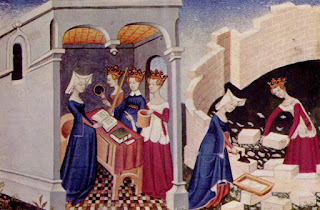European
women in the earlier years had limited rights in terms of economic and social
sectors. They were expected to act and dress in certain ways that adhere to
societal norms and expectations. In The Guerilla
Girls’ Bedside Companion to the History of Western Art, Linda Nochlin
addressed inequality between women and men and how it was addressed through art
and women’s roles in the Middle Ages that range from the 5th to 15th
century. During that time, feudalism was exercised, the social system divided the
society based on social and economic status. Not only was the society divided
between social classes, but it also established the value of individuals based
on gender. The church also had a big impact on the beliefs and values of the
society, since there was very limited access to education. According to the
bible, “…The head of every man is Christ, and the head of the woman is the man.
for man was not made from woman. But woman from Man. Neither was man made for
woman, but woman for man.” (New Testament, Corinthians 11:3-10). This biblical
teaching did not help the perception about women being inferior to men. The bibles
powerful statement that changed the lives of women forever: that women were
made for men. Women were created to serve men’s needs, no matter what they
might be. In fact, “…women were rarely allowed to attend art schools, join
artists’ guild or academies, or own atelier. Many were kept from learning to
read or write. For most of history, women have, by law, been considered the
property of their fathers, husbands, or brothers, who always believed women
were put on earth to serve them and bear children.” (Nochlin, 8) This prohibited
women to progress with their education and career because of their so-called
unconditional obligation to serve men. Luckily for Christine de Pizan, she
became the very first female writer and a single mother during the Middle Ages.
With the support of her father, she obtained her education despite her mother’s
disapproval. Her strength to carry on with her career as a writer was even
fueled when she became a widow at the age of 25 in order to support her
children. It was mesmerizing to see an outspoken woman in a male - dominated
society, where everyone thought that women were incapable of logic and reason.
She was also proven to be a strong woman because she provided for her children
without a husband. She inspired women to embrace their femininity and their
abilities that make them bold and brave by writing a long allegory called The City of Ladies (1405) inspired by three
fearless female characters that symbolized “Reason, Rectitude and Justice”
(Nochlin 26) .
 |
| The Bricklayers, From The City of Ladies, Christine De Pizan 1405 |
 |
| Susanna and the Elders, Artemisa Gentileschi (1610) |
 |
| Judith with her Maidservant, Orazio Gentileschi ( 1621 ) |
With the permission of the British
library, an illustration of The City of Ladies was shown. Pizan’s artworks
embodied the accomplishments of women despite all the criticisms that they
received from the past (Chadwick, 36).
Entering
the Renaissance period from 14th century to 17th century,
innovations in art, literature, politics and science start to progress. One may
be familiar with Italian Renaissance men such as Raphael, Michaelangelo and
Leonardo, but not the women artists. This is due to the fact that women were
not allowed to participate in painters’ guilds or academies, receive
commissions and own an altier, just like the Middle Ages. However, some women
were fortunate to be given an opportunity to develop their talents in painting
which was made possible because of their nobility. For example, Sofonisba
Anguissola’s noble father provided her education, and allowed her to work in
the family workshop. Another example is Maria Robusti, the
daughter of Jacopo Tintoretto. However, her identity as a woman was hidden so
that the father could take credit. It’s saddening to think that women had no
right to own anything, even their artwork. Men constantly take credit of what
they believe was theirs. Therefore, women were still objectified even in the
Renaissance period. A perfect example of this was a painting called Susanna and
the Elders by Artemisa Gentileschi. In the painting, the two elders were
collaborating to sexually abuse Susanna, but she refuses the male gaze.
Another
painting that might have demonstrated incredibility against women was Orazio
Gentileschi’s Judith with Her Maidservant. In the painting, Judith was a heroine
cutting off a man’s head, but it did not seem like she got the credit for it. In
fact, Judith looked clueless in the painting, and it seemed like the murder was
fake because there was no blood on the sword. This left the viewers with an
assumption that the painting was created based on myth, thus, discrediting
Judith’s power to kill the man.
In conclusion, the Middle Ages was an onerous period for women to
achieve equality, but so was the Renaissance period. Some efforts had been made
to improve women’s quality of life through equal wage, education, and civil
rights in the both Middle Ages and Renaissance period, but women remained
hidden and silent. However, empowering women should continue to work together
to eliminate social injustice.
Works Cited
Chadwick, Whitney.
Women, Art, and Society. 4th ed. New York, N.Y.: Thames and Hudson, 1990. Print.
The Guerrilla Girls' Bedside Companion to the History of Western Art. New York: Penguin, 1998. Print.
No comments:
Post a Comment